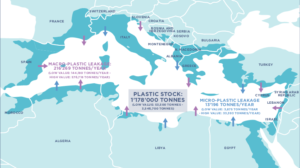
Since then, the report says that the state has paid significant attention to the water sector in Durres. The World Bank has also supported investment in the water supply network and in constructing pipes to link villages to the city water supply system.
Furthermore, the local sewerage system and its ability to transfer wastewater from the beach area to the wastewater treatment plant were enhanced. In the last few years, a total of five wastewater treatment plants providing service for almost 500,000 residents have been built in the country. This has gradually contributed to increased quality bathing conditions and better overall water quality.
As of 2019, only seven sites were classified as ‘poor’. This will lead to a better potential for tourism in Albania. The report notes that tourism contributes to 8% of the GRP and improving the quality of bathing water, it will pave the way for Albania to become an established and well-recognized tourist destination.
Locations that care a cause for concern include Sarande, Vlore, and Durres.
The report also looked at inland bathing waters and observed that lakes in Albania are at risk to the effects of drought. There will need to be adequate management of water levels while allowing enough for agriculture, industry, and tourism to continue, the report said.
Despite this positive assessment, Albania still has a problem with plastic waste being deposited into the sea. The Municipality of Tirana is the 4th biggest offender for leaking waste and plastic into the Mediterranean.
This is quite an achievement considering Durres which actually sits on the coast, only contributes 443 tonnes per year.
According to the IUCN “The Mediterranean: Mare plasticum” report, it leaks 1,123 tonnes of waste into the sea every year. It was beaten by Podgorica with 1662 tonnes, Rome with 1809 tonnes, and Muntazah with 1912 tonnes. It performed better than Skopje., Tripoli, and four other big Egyptian cities.
It’s estimated that in total, Albania leaks almost. 10,000 tonnes of plastic waste into the Mediterranean every year. This puts it in fifth place overall in terms of countries, beaten by Algeria, Turkey, Italy, and Egypt. According to the data, Albania is the worst offender for plastic waste passing into the ocean in the Western Balkans.
It notes that part of the issue is the fact that around 80,000 tonnes of plastic waste are mismanaged by the government- again, some of the highest rates in the region.
Every year, some 1.08 million tonnes of waste is produced by Albanians. Most of this goes into landfills, around 18% is recycled, and the rest is incinerated. INSTAT found that the average Albanian creates 381 kg of waste every year, according to this report, just over 3kg per person ends up in the sea.



Insider
Apr 08, 2021., 14:24 •
Seit 20 Jahren, als die Demokratie kam, wurden die Strände nicht mehr gesäubert. Milliarden Grab mit EU Geldern, die spurlos verschwanden in Betrugs Projekten. Finanziert die korrupte EU, wo hohe Millionen, MIlliarden Beträge mit Hoax Projekten spurlos verschwinden
06/04/2021 21:17
Albanian destroyed beaches; From Cape of Rodoni to Patok, plastic and garbage invade the coast
BuckZiehsMutter
Jul 14, 2022., 06:25 •
Illegale Bars, Strände Am Ende der Aufräumaktion kommen die Besitzer der Bar, zwei Jugendliche und ich schätze ihre Eltern. Ich rede noch kurz mit Matheo und frage ihn was für eine Reaktion er erwartet. Matheo ist sich sicher, dass sie es zu schätzen wissen. Ich bin der Meinung, dass sie es eher gleichgültig hinnehmen. Was wir aber dann erleben durften hätten wir beide nie erwartet und es erschüttert uns. Die Besitzer kommen wutentbrannt an und beschimpfen uns von der ersten Minute. Ein kleiner Bub ist dabei und kann uns teilweise das Gesagte ins Englische übersetzen. Es wird geschrien, was uns einfällt ihre Sachen anzufassen. Sie wollen Geld für die „nützlichen“ Sachen die wir verbrannt haben. Matheo ist verständlicherweise außer sich, die Diskussion wird immer heftiger und ich hoffe, dass es nicht ausartet. Matheo reist einen Sack auf und schmeißt aus Protest die Dosen und Flaschen auf den Boden. Die Leute der Bar reden noch irgendwas, dass das nun unser Problem ist und machen sich aus dem Staub. Wir alle sind äußert schockiert über diese Reaktion und verstehen die Welt nicht mehr. Da will man helfen, opfert einen halben Tag um den Dreck anderer zu beseitigen und als Dank dafür wird man beschimpft, beleidigt und soll auch noch dafür zahlen. http://t4travel.de/index.php/2015/11/13/25-gjipe-teil-3-olivenernte-und-ein-muellproblem-am-strand/